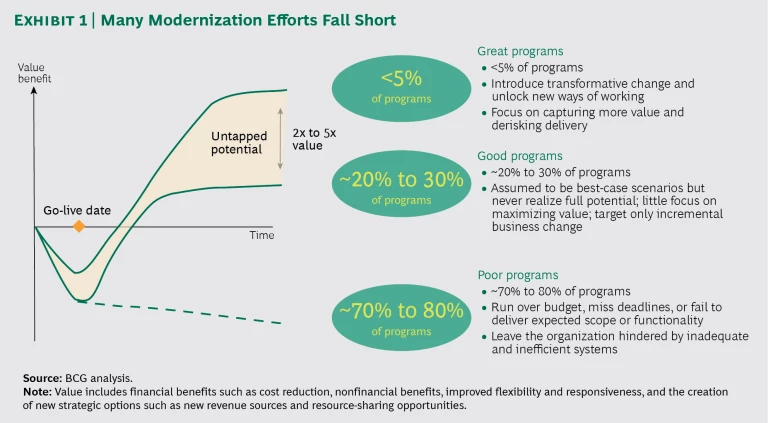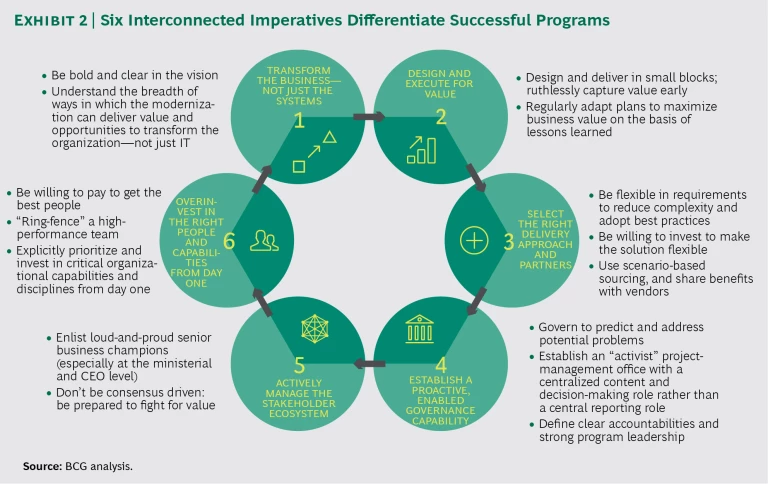When it comes to technology in the public sector, the buzz is all about the power of digital technologies to transform the ways governments operate and deliver services to citizens. Certainly, that shift is real and transformational. What is often left out of that discussion, however, is the need for a modern IT backbone to make the digital revolution possible and to support the ever-increasing need for agility, real-time information, and customization of services. This backbone—or core system—must be able to process large amounts of information reliably, accurately, and securely, as well as maintain the integrity of critical data such as citizen records. Unfortunately, around the world, many core systems are aging and no longer able to meet government needs. And most attempts to modernize these systems fail or yield disappointing results.
The time has come to raise the bar on such efforts. The Boston Consulting Group estimates that “great” modernizations can create value that is two to five times higher than those modernizations that simply come in on time and within budget. That value comes in the form of improved efficiency and effectiveness of the department and more convenient and tailored services for citizens and businesses. Delivering a great modernization, however, requires more than IT competence and basic project-management skills. On the basis of extensive experience in technology-enabled modernizations in both the public and private sectors, we have identified six important actions that government departments must undertake concurrently:
- Transform the business—not just the systems.
- Design and execute for value.
- Select the right delivery approach and partners.
- Establish a proactive, enabled governance capability.
- Actively manage the stakeholder ecosystem.
- Overinvest in the right people and capabilities from day one.
It is not easy to execute well in all areas, but average results are no longer sufficient. Governments must rise to the challenge by setting bold goals and lifting their readiness for execution. Doing so will allow them to engineer a truly great technology transformation.
Why Great Projects Are the Exception, Not the Rule
Governments are making significant investments in IT. Global investment reached $429 billion in 2015 and is expected to rise to $476 billion by 2020.
To understand what drives success in core-system modernizations, BCG studied modernization projects worldwide, including numerous public- and private-sector transformations that the firm has supported. We also interviewed a number of public-sector experts who had led core-system modernizations, to get their insights on best practices. (See “Dispatches from the Frontlines.”)
DISPATCHES FROM THE FRONTLINES
To clarify our understanding of what exactly makes—or breaks—a core-system transformation program, BCG interviewed three experts from around the world who have direct experience in leading and implementing core-system modernization efforts.
Peter Blaschke
CEO, BWI Informationstechnik
Blaschke led the German Federal Armed Forces’ Herkules modernization pro-gram to deliver a resilient information and communications technology (ICT) infrastructure platform. Conducted as a public-private partnership that lasted for more than ten years, the Herkules program encompassed the transformation of the entire nonmilitary ICT infrastructure for the nation’s armed forces.
Greg Farr
Former CIO, Australian Department of Defence, and Former Second Commissioner, Australian Taxation Office
Farr was the leader of the implementation of a new core system for taxation, which was an aspect of the Australian Taxation Office’s Change Program. He also led a $1 billion ICT reform program, replacing multiple core systems, when he was the CIO of Australia’s Department of Defence from 2007 through 2012.
Mikey Dickerson
Administrator, US Digital Service
The current administrator of the US Digital Service, Dickerson previously led the recovery of the US HealthCare.gov platform. He now supports the modernization of multiple systems across the US government.
On the basis of that work, we found that core-system upgrades are inspired by a number of factors.
First, increasing numbers of citizens expect to conduct business with government using their mobile devices in a way that is as simple as downloading a song from iTunes or buying a product from Amazon.com. Many government systems, however, were developed decades ago and are limited in their ability to support new digital user interfaces and tools. Many of these systems, for example, rely on batch—rather than real-time—processing. BCG research in 21 countries determined that 43% to 82% of citizens are satisfied with online government services. Although this is a significant improvement over 2014 results, the data indicates that in many countries, satisfaction and usage levels remain low. On average, only 40% of surveyed citizens used digital government services once a week or more, with some countries experiencing usage as low as 23% and others as high as 69%.
Second, many of today’s core systems are inflexible, making it difficult for agencies and departments to respond to new legislation and regulations that might require extensive and time-consuming systems or coding changes. Third, the skills required to maintain these legacy systems are in short supply, as many programmers with such expertise are moving into retirement. And fourth, more and more agencies and departments are able to exploit new off-the-shelf software that can reduce the cost and risk of modernization, a trend that is spurring government technology leaders to action.
We spoke with Peter Blaschke, CEO of BWI Informationstechnik, a public-private partnership that was established to modernize the German Federal Armed Forces’ information and communications infrastructure. He told us, “We had such obsolete technology that repairs were no longer effective and a completely fresh start was required.” Furthermore, he added that they “had a number of IT security risks due to a lack of standards and effective IT governance. Critically, we also had a shortage of skills available within the organization to support this aging technology and very little prospect of closing that shortage.”
For governments that successfully manage the transition to digital services, the benefits are significant. Greg Farr, formerly Australian Department of Defence CIO and second commissioner of the Australian Taxation Office, witnessed this firsthand after that agency’s core-system modernization. “The majority of people comply with the tax system if they know how and if it’s easy,” he pointed out. “Some of the things we did at the time made it easy for them—and quicker. But at the same time, we also sought to design a system where we can catch anomalies in real time. Things like being able to say to them once they have entered data, Did you really mean that? Or, Last year you said this; why is it different this year? More smarts built into the front end means less work in the back end.”
Still, governments face significant challenges as they attempt to conduct technology-enabled transformations. Certain obstacles make it more difficult to achieve success in the public sector than in the private sector. For one thing, because many government agencies and departments lack experience with large modernization projects and are typically risk averse, their projects end up being over-engineered and less than ambitious. In addition, the mismatch between annual public-sector budget cycles and the time frames associated with large projects means that project timelines are often focused more on political considerations and influence than on rational planning.
The public scrutiny of government projects also complicates matters. Not only does it cause leaders to be risk averse—resulting in less than ambitious projects—it also encourages inflexibility. After all, leaders are wary of being branded flip-floppers should they change course midstream—even if compelling evidence supports a shift. And given the large number of stakeholders—including, agency staff, other government agencies, and the public—potentially affected by changes in core systems, building consensus is difficult and can lead to major delays and what we call lowest-common-denominator solutions. The upshot: many public-sector modernization programs fail or deliver mediocre results at best.
On the basis of our experience with large IT projects in both the public and the private sectors, BCG estimates 70% to 80% of public-sector core-system modernizations either fail outright or are disappointments: they have budget overruns, missed deadlines, or fail to deliver expected functionality. (See Exhibit 1.) Another 20% to 30% fall in the “good” range: they deliver largely within budget and on time and essentially meet the general objectives. But they are not transformative, and they don’t realize their full potential. A slim minority—less than 5%—are great. These projects not only come in on time and on budget but also deliver substantial financial benefits (such as dramatically lower costs), nonfinancial rewards (such as an improvement in the quality of services delivered to citizens and businesses), and new strategic options (such as resource-sharing opportunities and new revenue streams).
How to Deliver Exceptional Core-System Modernizations
There has been no lack of ink spilled explaining why so many major core-system replacement projects fail. What is less understood is what is required from the outset in order to be great.
What does distinguish the rare projects that deliver maximum impact from those that are mediocre? The key is to understand the opportunity—to be bold and ambitious enough to capture the potential value—and then to ensure that the organization executes successfully. (See “ Getting Fit for Transformation ,” BCG article, July 2015.) BCG has identified six success imperatives that characterize great modernizations. (See Exhibit 2.) Organizations that integrate action in all six areas into their core-system overhauls can deliver winning transformations.
Transform the business—not just the systems. Typically, the starting point for a modernization effort is an overall push to cut costs—through, for example, system simplification or reduced maintenance expenses—and a drive to improve IT’s responsiveness to business needs, government policy changes, or both. Such efforts often reduce IT costs and risks, but they are rarely transformative.
What distinguishes the great modernizations is a focus on transforming how the government operates. This involves attention to two areas. The first calls for digging into the way things are done within the agency or department. This might include finding new processes to meet the needs of the department and citizens, segmenting citizens and tailoring services to the resulting citizen groups, or tying together services that are delivered through various agencies to provide more integrated services.
The second area requires rethinking the way that the services are actually delivered, potentially shifting to self-service models or enabling greater personalization of the process by which citizens connect with the government to obtain services. For example, in border management, governments are streamlining passenger border clearance by identifying low-risk passengers and using biometric identification to allow them to pass through automated border gates.
For the system modernization of the Australian Taxation Office, a number of the project’s internal senior leaders spent time brainstorming about how the technology could transform the way the organization operated. Greg Farr told us that they “came up with propositions that weren’t just the existing system with some whistles and bells. Instead, it was things like making everything more open and connected. This included, for example, linking community systems such as share registries [which maintain citizen information related to investment holdings] with tax systems, which at the time was very radical.”
Design and execute for value. It is conventional wisdom that big IT projects should be executed on the basis of a firm, detailed design and execution plan that has clear milestones and multiyear funding aligned with the government’s budgeting cycle. This often involves making large, initial investments and then focusing on generating the best payoff from that infrastructure.
Such an approach, however, overlooks the fact that new information emerges over time and that circumstances frequently change. Therefore, system design and execution plans should be flexible and adaptive. And rather than involving a big, upfront investment, implementation should be conducted in small, manageable pieces, and high-value, low-risk components should be rolled out first. This not only ensures some early wins but also allows lessons to be gathered and distilled so that the effort can be adjusted and improved throughout implementation. This approach is also more amenable to agile delivery methodologies and approaches that use rapid work cycles to allow new lessons and insights to be quickly incorporated into the project development effort.
According to Mikey Dickerson, administrator of the US Digital Service, the notion of dividing programs into discrete components is often at odds with the public-sector mindset. “A big ambitious plan and a huge budget are exciting, and people think that must mean you’re important,” he told us. “Taking a small piece of that plan and doing a small contract for a small amount of money where the risk is contained must therefore mean you’re not important or whatever you’re doing is not very exciting. That’s a perception problem that holds us back from breaking the problem into smaller pieces where each piece is small enough that it can fail without it being a catastrophe. This is something that we have to actually learn how to do properly.”
Select the right delivery approach and partners. When it comes to developing and implementing the new systems, selection of the right technology solution and right partners is crucial. Agencies and departments typically run a vendor selection process in which they evaluate vendors’ ability to meet detailed requirements and technology solutions. And contracts are typically centered on the specific activities the vendor is to carry out, service-level agreements, and elements of risk sharing.
Great programs, however, take a different tack in three key areas. First, vendors are selected not only on the basis of their capability to meet key requirements but also on their ability to innovate and adapt. In many cases, this means using a scenario-based selection process in which a small number of possible suppliers outline how they would respond to several different situations and how their system would perform in each case. (See Renovate in Winter: Taking Advantage of the Downturn to Modernize Core Systems in Banking, BCG Focus, May 2009.)
Second, investments are made upfront to explicitly build flexibility into the solution, anticipating that not all requirements are known from the outset. And third, contracts have clear links to outcomes and are structured so that the agency and vendors share in the success and risks associated with the project.
Retaining flexibility was particularly important for Peter Blaschke. The German Federal Armed Forces’ modernization involved the creation of a ten-year public-private partnership and a timeline that made it critical that the agreement between the two parties—the German Federal Armed Forces and its lead contractor—allow for shifts in strategy.
“Herkules has a contractual provision that takes into account the necessity of adjustment over the course of a ten-year project,” Blaschke told us. “The German Federal Armed Forces thus has the possibility to revise the services provided at any time, based on new developments, while still fulfilling its contractual obligation. The contract also had a kind of ‘modernization clause’ to ensure that the technology would always be kept up to date.”
Mikey Dickerson noted that in addition to flexibility, some level of risk sharing is paramount. “These technology projects fail all the time in very predictable ways,” he said. “We hire contractors for hundreds of millions—sometimes billions—of dollars, and then put them on a seven-to-ten-year time frame where they’re going to spend two or three years gathering requirements. We repeat this pattern again and again and again, and it almost never works. So we need to reinterpret the incentives model that people respond to: it’s broken if nothing bad happens to people who build products that don’t work.”
Establish a proactive, enabled governance capability. It is an established best practice to have a project management office (PMO) in place to track and report on the progress of the core-system overhaul and to identify potential problems. But, in many cases, PMOs have no real decision-making authority and are too reactive and process oriented.
The best efforts, however, will have a highly “activist” PMO. With a forward-looking focus, such a PMO identifies problems and risks early, tackling them head-on. It develops realistic plans with regular milestones that are linked to the actual value delivered rather than to simply meeting process checkpoints. At the same time, the PMO does not simply report on progress, it initiates action, synthesizing input from teams working on various components of the project, identifying problems, making clear recommendations, and taking direct action when necessary. And the PMO has the authority to make or facilitate design-related decisions in order to ensure the integrity of the overall solution.
Actively manage the stakeholder ecosystem. It is hardly news that system overhauls often require the involvement and support of many groups—citizens, businesses, unions, government employees, and other departments—affected by the change. And many modernization efforts do include detailed plans for identifying and communicating with those stakeholders in order to garner their input and build consensus.
A great modernization, however, goes beyond that. Highly successful projects typically cast a wide net in terms of communicating and working with stakeholders and tailoring outreach to each group on the basis of its interest and influence. Most important, the focus needs to be on delivering maximum value from the project—not on building blanket consensus around solutions. So, in some cases, the effort will need to forgo achieving consensus and will ruffle some feathers. The group leading such an overhaul needs to be very transparent about its decision-making processes, spelling out the logic for its moves, especially to those with different views.
Insight on stakeholder needs was critical for Greg Farr when he was at both the Australian Department of Defence and the Australian Taxation Office. “You need to make sure you understand from the stakeholders’ perspective what it is you’re going to do and make sure you can define what success looks like from their viewpoint so that they can actually sign up for it,” he explained. “And you have to find some really trusted colleagues who you can depend on to run the program and who will still be there when you go. Otherwise what you’ve started is likely to just fade away.”
Stakeholder management was particularly challenging for Peter Blaschke, who had to deal with a number of negative media headlines, including stories that overstated project costs. “Management had to respond very early on to bad—and sometimes patently false—press reports with communications policies that kept key stakeholders informed on the status of the project.” He added, “This included [individuals within] important functions in the Ministry of Defense, the military, and the Bundestag [the Parliament of the Federal Republic of Germany], all of whom were interested in the progress of the project.”
Overinvest in the right people and capabilities from day one. When it comes to the talent and capabilities needed to drive a complex core-system transformation, agencies and departments may be too inwardly focused, bringing together the best people from within the organization and using existing structures and processes to manage the effort.
Although that approach might be enough for a decent result, it rarely produces an exceptional one. To achieve that, there needs to be recognition that the best people might not already be part of the organization. Instead, those leading the effort should go outside to recruit the right talent when necessary. There must be an honest skill assessment at the outset, an evaluation that will provide the foundation for the development of a detailed program for recruiting the required talent and building the skills needed. It is crucial to start building and “ring-fencing” the right team from day one—a need that is often overlooked when implementation may be years away.
At the Australian Taxation Office, Farr believes, more effort should have been made to ensure that the necessary in-house capabilities were available. “When I look back, one thing that I kick myself about is that we spent so much time getting the business case right,” he told us. “The business case was good—even if I do say so myself—but we just didn’t have the capability to immediately execute, because we didn’t have the right people.”
Pressure is building on governments to modernize their remaining legacy core systems. Agencies and departments preparing to embark on a core-system modernization—or even those in the midst of one—should step back and make a clear-eyed assessment: Have we been sufficiently ambitious in identifying the real opportunity presented by the transformation? How ready is the organization to execute? Such an effort inevitably brings tough strategic decisions. After all, the goal is not simply to upgrade an IT system. Rather, it is to transform the very operations of government and its interactions with citizens.










